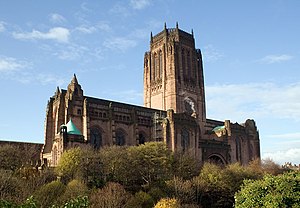Internet says:
Identification
Name
Remsen Building
NYC BIN
1017000
Emporis Building Number
140615
Location
| 148-150 Madison Avenue |
| 22-24 East 32nd Street |
Address as text
148 Madison Avenue at 32nd Street, SW corner
ZIP
10016
Block
861
Lot
100052
Zone
Neighborhood
District
City
State
Country
Longitude
*
Latitude
*
Also:
The Gothic style dictated the use of structural members in compression, leading to tall, buttressed buildings with interior columns of load-bearing masonry and tall, narrow windows. But by the turn of the 20th century, technological developments such as the steel frame, the incandescent light bulb and the elevator led many to see this style of architecture as obsolete. Steel framing supplanted the non-ornamental functions of rib vaults and flying buttresses, providing wider open interiors with fewer columns interrupting the view.
Some architects persisted in using Neo-Gothic tracery as applied ornamentation to an iron skeleton underneath, for example in Cass Gilbert's 1913 Woolworth Building skyscraper in New York and Raymond Hood's 1922 Tribune Tower in Chicago. But over the first half of the century, Neo-Gothic became supplanted by Modernism. Some in the Modern Movement saw the Gothic tradition of architectural form entirely in terms of the "honest expression" of the technology of the day, and saw themselves as the rightful heir to this tradition, with their rectangular frames and exposed iron girders.
 In spite of this, the Gothic revival continued to exert its influence, simply because many of its more massive projects were still being built well into the second half of the 20th century, such as Giles Gilbert Scott's Liverpool Cathedral. Ralph Adams Cram became a leading force in American Gothic, with his most ambitious project the Cathedral of Saint John the Divine in New York (claimed to be the largest Cathedral in the world), as well as Collegiate Gothic buildings at Princeton University. Cram said "the style hewn out and perfected by our ancestors [has] become ours by uncontested inheritance."
In spite of this, the Gothic revival continued to exert its influence, simply because many of its more massive projects were still being built well into the second half of the 20th century, such as Giles Gilbert Scott's Liverpool Cathedral. Ralph Adams Cram became a leading force in American Gothic, with his most ambitious project the Cathedral of Saint John the Divine in New York (claimed to be the largest Cathedral in the world), as well as Collegiate Gothic buildings at Princeton University. Cram said "the style hewn out and perfected by our ancestors [has] become ours by uncontested inheritance."
Though the number of new Gothic revival buildings declined sharply after the 1930s, they continue to be built. The cathedral of Bury St. Edmunds was constructed between the late 1950s and 2005.[11] A new church in the Gothic style is planned for St. John Vianney Parish in Fishers, Indiana.[12][13]
The Gothic style dictated the use of structural members in compression, leading to tall, buttressed buildings with interior columns of load-bearing masonry and tall, narrow windows. But by the turn of the 20th century, technological developments such as the steel frame, the incandescent light bulb and the elevator led many to see this style of architecture as obsolete. Steel framing supplanted the non-ornamental functions of rib vaults and flying buttresses, providing wider open interiors with fewer columns interrupting the view.
Some architects persisted in using Neo-Gothic tracery as applied ornamentation to an iron skeleton underneath, for example in Cass Gilbert's 1913 Woolworth Building skyscraper in New York and Raymond Hood's 1922 Tribune Tower in Chicago. But over the first half of the century, Neo-Gothic became supplanted by Modernism. Some in the Modern Movement saw the Gothic tradition of architectural form entirely in terms of the "honest expression" of the technology of the day, and saw themselves as the rightful heir to this tradition, with their rectangular frames and exposed iron girders.

Liverpool Cathedral, whose construction ran from 1903 to 1978
Though the number of new Gothic revival buildings declined sharply after the 1930s, they continue to be built. The cathedral of Bury St. Edmunds was constructed between the late 1950s and 2005.[11] A new church in the Gothic style is planned for St. John Vianney Parish in Fishers, Indiana.[12][13]

No comments:
Post a Comment
Please leave a comment-- or suggestions, particularly of topics and places you'd like to see covered